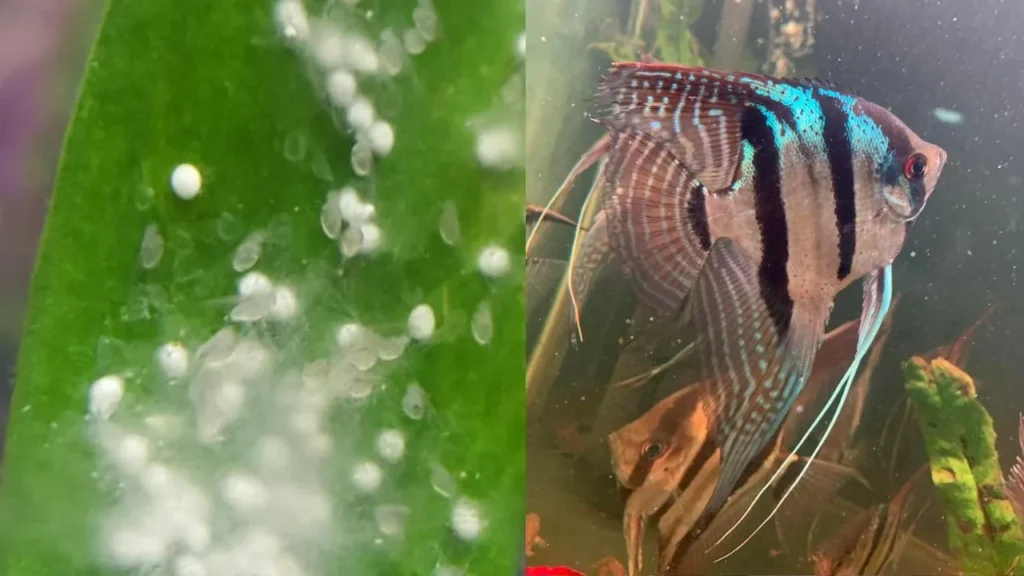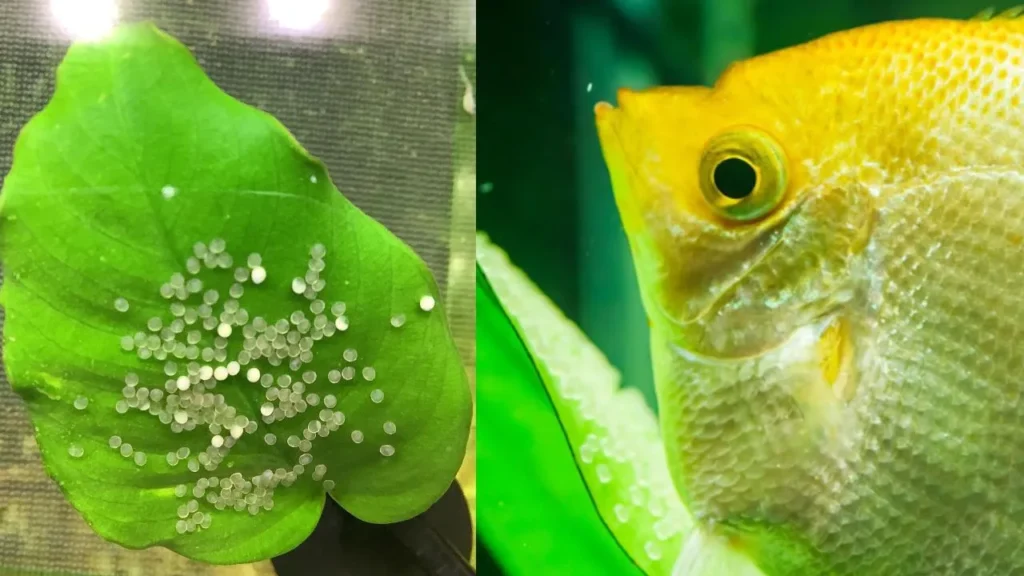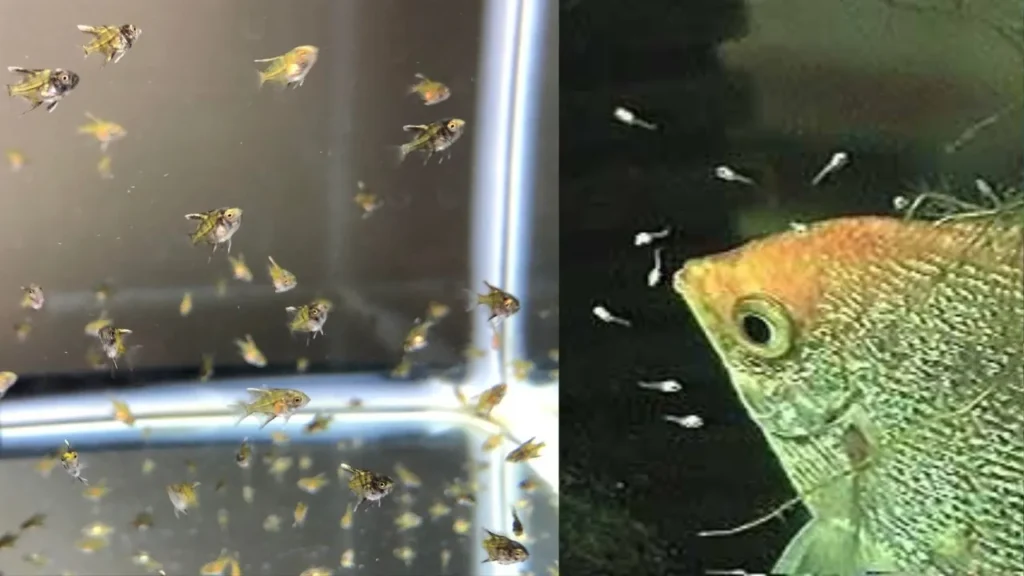
What do angelfish eggs look like? Breeding angelfish lets you see the amazing start of life right before your eyes. Angelfish are really pretty and colorful, making them a popular choice for people who like to breed fish. This article will tell you all about stages of angelfish eggs, how often do angelfish lay eggs, how long do angelfish eggs take to hatch, how to tell if angelfish eggs are fertilized, what they look like, how they grow, and the steps they go through before they hatch.
Angelfish Mating Behavior and Egg Laying Process
Before we can understand what do angelfish eggs look like, it’s essential to familiarize ourselves with their mating behavior and the process of egg laying. When angelfish reach sexual maturity, they engage in an elaborate courtship ritual. This ritual involves the male and female swimming together, displaying their vibrant colors, and engaging in intricate fin movements. Once the pair establishes a strong bond, they will find a suitable location to lay their eggs.
Angelfish typically prefer to lay their eggs on a flat surface, such as a broad leaf or a piece of slate. The female angelfish releases her eggs, while the male follows closely behind, fertilizing them as they fall. The number of eggs can vary significantly, ranging from a few dozen to several hundred, depending on the size and age of the female. Once the eggs are fertilized, the parents take turns guarding and caring for them, ensuring their survival.
Also Read: Recognizing Female Pregnant Angelfish.
What Do Angelfish Eggs Look Like?

So a common question arise is what do angelfish eggs look like! Angelfish eggs have distinct characteristics that can help determine their health and fertility. When fertilized, angelfish eggs have a color ranging from translucent amber to brown. This color indicates that the eggs are healthy and developing correctly. On the other hand, unfertilized eggs may turn white and develop a fungus, which reduces the chances of successful hatching.
Monitoring the color of the eggs is crucial to ensure their viability. The presence of a healthy color indicates that the eggs are fertilized and progressing well. If the eggs turn white and opaque, it is necessary to take immediate action to rectify the situation and protect the healthy eggs.
Understanding the Stages of Angelfish Eggs
Angelfish eggs go through several stages from the moment they are laid until they hatch into fry. It is essential to understand the stages of angelfish eggs and provide the necessary care to increase the chances of a successful breeding cycle. Let’s delve into the different stages of angelfish eggs:

1. Preparing the Breeding Area
Before angelfish lay their eggs, they meticulously clean the chosen spawning site. This process ensures that the environment is suitable for egg deposition. The breeding area can be a tank wall, heater, or a designated breeding slate. It is crucial to provide a removable spawning site to facilitate egg transfer if necessary.
2. Egg-Laying
Once the spawning area is clean, the female angelfish begins laying her eggs in rows. The male angelfish follows closely, fertilizing the eggs. Angelfish eggs are translucent and smaller than the head of a straight pin. The eggs stick to the spawning area, and the parents diligently guard and clean them.
3. Tank Maintenance
During this stage, it is essential to maintain a stable and optimal environment for the eggs. Any sudden changes or disturbances can stress the angelfish and increase the risk of them eating their eggs. It is advisable to remove the eggs and transfer them to a separate breeding tank to ensure their safety.
4. Larval Pre-Hatching Stage
After approximately 60 hours, the larvae inside the eggs begin their pre-hatching stage. The larvae curl around the yolk sac, and the eggs become more transparent. Under a microscope, you can observe the beating heart and blood flow within the larvae.
5. Wiggler Stage
Once the eggs reach the wiggler stage, the larvae are still attached to the spawning site through a filament. During this stage, the larvae develop their eyes, tails, and internal organs. They feed on the yolk sac for nourishment.
6. Free-Swimming Fry
After about 3 to 5 days, the larvae become free-swimming fry. They detach from the spawning site and start swimming independently. At this stage, their eyes are fully developed, and you can observe their respiration under a magnifying glass. The fry can survive on microscopic organisms in the tank, such as infusoria, for the first two days.
Read More: Angelfish Breeding Season And Slate.
How Long Do Angelfish Eggs Take to Hatch?

The time it takes for angelfish eggs to hatch varies depending on various factors, including water temperature and genetics. On average, it takes approximately 60 to 72 hours for the eggs to hatch. However, deviations from this timeframe are not uncommon. If the water temperature is slightly cooler, the hatching process may take a bit longer, while warmer temperatures can accelerate it.
During the hatching process, you may notice the eggs becoming more transparent, and the fry inside will become increasingly visible. Eventually, the fry will emerge from the eggs, often in groups, and embark on their journey into the world. It is crucial to provide a suitable environment for the fry, including appropriate food and shelter, to ensure their survival and healthy growth.
How to Tell if Angelfish Eggs Are Fertilized
In the process of breeding a beginner fish keeper would struggle to Determining whether angelfish eggs are fertilized or not. So how to tell if angelfish eggs are fertilized or not! One way to check for fertilization is to observe the eggs closely. Fertilized eggs will undergo a color change, as mentioned earlier, transitioning from transparent to golden or amber tones. Additionally, you may notice tiny white dots appearing on the eggs’ surface, which are the developing blood vessels of the embryos. This process can be an exciting and rewarding experience for breeders.
Another method to confirm fertilization is to gently shine a flashlight through the eggs. If the eggs are fertilized, you will be able to see the developing embryos inside. However, it is crucial to handle the eggs with care and avoid excessive disturbances, as this can harm or stress the embryos. Patience and observation are key when determining the fertility of angelfish eggs.
Angelfish Eggs Turning White: Causes and Solutions
If angelfish eggs turn white, it is a cause for concern as it indicates potential issues with their development and hatching. Several factors can contribute to the discoloration of angelfish eggs:
1. Fungal Infections
One common cause of white angelfish eggs is a fungal infection. Fungus can develop on unfertilized or damaged eggs, hindering their ability to hatch successfully. Treating the water with a fungicide, such as methylene blue, can help prevent and control fungal growth.
2. Unfertilized Eggs
Unfertilized angelfish eggs are more prone to turning white and failing to hatch. If the eggs remain unfertilized for an extended period, their chances of successful development decrease. Removing unfertilized eggs can help protect the healthy ones and prevent potential contamination.
3. Poor Water Conditions
Poor water quality can also contribute to the discoloration of angelfish eggs. High ammonia or nitrite levels, inadequate oxygenation, or improper temperature can negatively impact egg development. Maintaining optimal water parameters and regular water changes are essential for ensuring the health and viability of the eggs.
4. Transfer-Related Casualties
Transferring angelfish eggs from one tank to another can be stressful and increase the risk of damage or contamination. If not done carefully, the eggs may turn white and fail to hatch. Ensuring a smooth and gentle transfer process is crucial to minimize any potential harm to the eggs.
How Often Do Angelfish Lay Eggs?
Another common question arrive in the mind of a beginner breeder is how often do angelfish lay eggs? Although angelfish are prolific breeders, but the frequency of egg-laying depends on various factors such as the age, size, and type of the angelfish pair.
In general a female angelfish can lay between 100 and 1,000 eggs in one breeding cycle. With an established mating pair, angelfish can spawn every two weeks, especially if the eggs are removed promptly after laying. This frequent spawning provides ample opportunities for learning and improving the breeding process.
Angelfish Laying Eggs Without a Male – Can It Happen?

Angelfish typically require a male for successful reproduction. Females lay the eggs, and males fertilize them. However, in rare cases, female angelfish can lay unfertilized eggs without the presence of a male. These eggs will not develop and hatch into fry.
The reasons for angelfish laying unfertilized eggs without a male can vary. It may be due to hormonal imbalances, inadequate breeding conditions, or the absence of a compatible mate. If a female angelfish consistently lays unfertilized eggs, it could indicate a need for further investigation and adjustments to the breeding setup.
Tips for Successfully Breeding Angelfish
Breeding angelfish can be a rewarding and fulfilling experience. To increase your chances of successful breeding, consider the following tips:
- Provide a suitable breeding environment: Ensure your tank setup includes appropriate hiding spots, broad leaves, and smooth surfaces for the angelfish to lay their eggs.
- Maintain optimal water conditions: Regularly monitor water parameters such as temperature, pH, and ammonia levels to create an environment conducive to successful breeding.
- Balance the male-to-female ratio: To prevent aggression and maximize breeding success, maintain a ratio of one male to two or more females.
- Offer a varied diet: Providing a diverse diet that includes live or frozen foods will enhance the health and reproductive capabilities of your angelfish.
- Patience and observation: Breeding angelfish requires patience and careful observation. Monitor the behavior and condition of your fish regularly to ensure their well-being.
Read More: Complete Angelfish Care Guide.
Conclusion
Understanding the stages of angelfish eggs is crucial for successful breeding and hatching. From the preparation of the breeding area to the care of the eggs during each stage, consistent monitoring and appropriate interventions are necessary. Recognizing the signs of fertilization, identifying potential issues such as egg discoloration, and providing optimal water conditions will increase the chances of successful angelfish breeding. With proper care, angelfish eggs will hatch into vibrant fry, adding beauty and joy to your aquarium.

